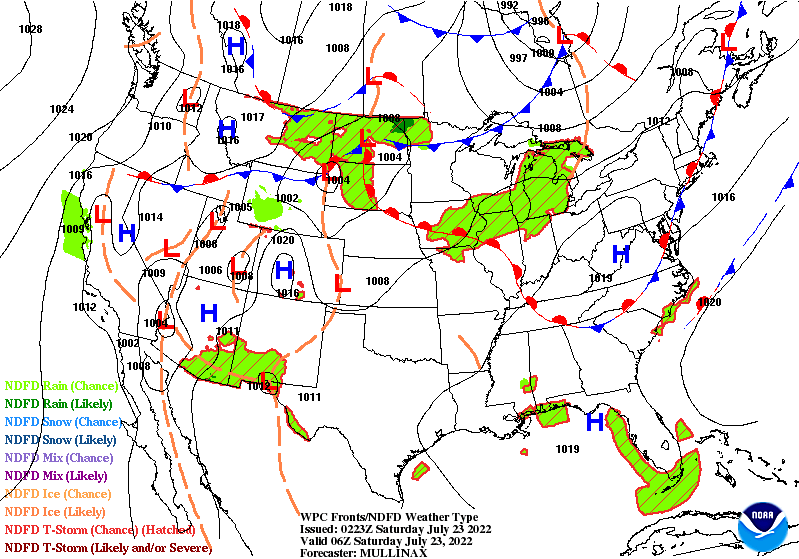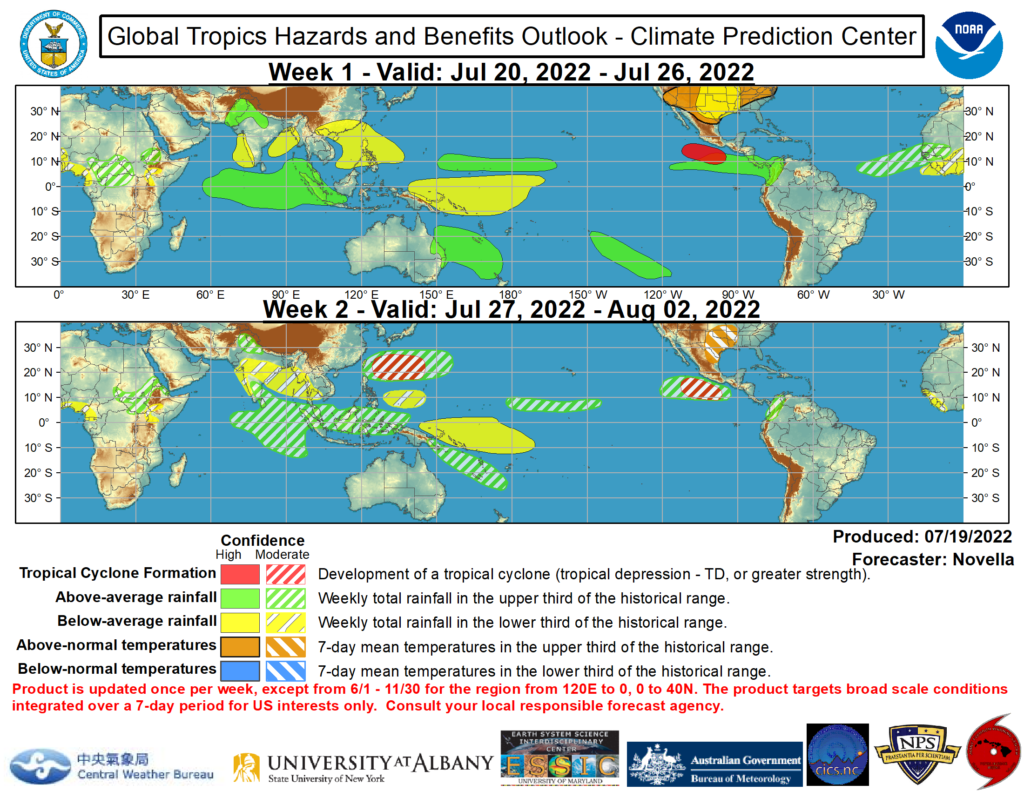Here is what we are paying attention to this evening and the next 48 hours from this evening’s NWS Forecast.
...Searing heat wave to engulf much of the Heartland, Mid-South, and Northeast Coast this weekend.... ...Enhanced Risk for severe storms in the Midwest on Saturday... ...Monsoonal moisture to gradually bring locally heavy rains and isolated flash flooding across portions of the Southwest into the Southern Rockies this weekend... ...Critical Fire Weather Risk in eastern Idaho today...
Continuation of the NWS Short Range Forecast (It is updated twice a day and these updates can be found here.
A strengthening upper level ridge stretching from the Southwest to the East Coast will keep stifling heat in the forecast from the Desert Southwest to the Northeast this weekend. Excessive Heat Warnings are in effect for much of the Desert Southwest and a large portion of the Central Plains and Middle Mississippi River Valley are under Heat Advisories. By Saturday, sizzling temperatures take hold of the Middle Mississippi Valley and Central Plains with forecast high temps likely to surpass the century mark. Temperatures also heat up into the upper 90s in the Northeast with some record highs possible from the Central Rockies to the Megalopolis of the Northeast. The heat wave finally crescendos on Sunday when the Northeast sees the return of oppressive humidity levels combined with upper 90s highs, resulting in widespread record highs and >105 heat indices in parts of the Northeast and Mid-Atlantic. The Central Plains will also struggle to stay cool with highs eclipsing the century mark once again. It is also important to note that Sunday morning features the potential for numerous record warm lows with some lows in parts of the Southern Plains struggling to drop below 80 degrees. There is some good news in the medium range as an approaching cold front brings a brief injection of cooler temps to the Midwest and Northeast, but the core of the intense heat shifts to the South-Central U.S. and Pacific Northwest early next week. By Saturday, a more potent upper trough tracking across the southern Canadian Prairies will prompt a strong cold front to sweep across the North-Central U.S., resulting in a more organized severe weather threat in the Midwest. SPC has issued an Enhanced Risk (threat level 3/5) for portions of the Upper Mississippi Valley, which does include the Twin Cities metro area. Damaging winds, large hail, and tornadoes are all possible within severe storms on Saturday. Some of these storms across the Midwest may also produce areas of flash flooding. By Sunday, the severe threat looks to extend from the Midwest to the Lower Great Lakes as the cold front approaches those regions. Across the southern tier of the U.S., monsoon showers and thunderstorms will develop each day in the Southwest with progressively heavier downpours potentially leading to areas of flash flooding. WPC has issued a Marginal Risk (Threat level 1/4) of Excessive Rainfall for parts of eastern Arizona, southern Colorado, and most of New Mexico for tonight. A stronger push of tropical moisture arrives this weekend, prompting the issuance of a Slight Risk (threat level 2/4) of Excessive Rainfall in southeast Arizona both Saturday and Sunday, while a Slight Risk was also issued for parts of the Colorado Rockies for Sunday. In the Deep South, a Marginal Risk of Excessive Rainfall is in place today from the ArkLaTex on east to the Carolina coast and Virginia Tidewater. Torrential rainfall within slow moving thunderstorms may lead to flash flooding Friday afternoon and evening. On the fire weather front, a Critical Risk for fire weather has been posted for parts of the Snake River Plain in eastern Idaho where a dangerous combination of gusty winds, very low humidity levels, and hot temperatures support the threat for dangerous fires into the early evening.
Maps that relate the forecast to geography can be found by clicking Here for Day 1 and Here for Day 2.
Here is a 60-hour animated forecast map that shows how the short-term forecast is expected to play out.
If it needs to be updated click here.
HAZARDS OUTLOOKS
Click here for the latest complete Day 3 -7 Hazards forecast which updates only on weekdays. Once a week probably Monday or Tuesday I will update the images. I provided the link for reads to get daily updates on weekdays. Use your own judgment to decide if you need to update these images.
Worldwide Tropical Forecast
(This graphic updates on Tuesdays) If it has not been updated, you can get the update by clicking here
Detailed Maps and Reports for the Western Atlantic and the Pacific Oceans
Below are three maps that summarize the situation for the Atlantic, Eastern and Central Pacific. Additional information can be accessed by clicking HERE
First the Atlantic
Click to view the forecast map and have access to additional information https://www.nhc.noaa.gov/gtwo.php?basin=atlc&fdays=5
Then Eastern Pacific
Click to view the forecast map and have access to additional information https://www.nhc.noaa.gov/gtwo.php?basin=epac&fdays=5
Then Central Pacific
Click to view the forecast map and have access to additional information https://www.nhc.noaa.gov/gtwo.php?basin=cpac&fdays=5
And the Western Pacific
Click to view the forecast map and have access to additional information https://www.metoc.navy.mil/jtwc/jtwc.html
Some Intermediate-Term Outlooks
Links to “Outlook” maps and discussions for three time periods. Days 6 – 10, Days 8 – 14, and Weeks 3 and 4. An outlook differs from a forecast based on how NOAA uses these terms in that an “outlook” presents information from deviation from normal and the likelihood of these deviations.
You have to click on the links because they do not update automatically and I do not want to have stale images in the article. But it is not difficult to click on a link and you get a large image plus a discussion. On Fridays in a separate article, we will show the images and provide a link in this article that article. But remember what you will see is the images as of Friday. But here you can get the current images simply by clicking on them. Then hit the return arrow at the upper left of your screen to return to the article. You will not find this information easily anywhere else.
Right now you can find these maps here (We show them every Friday there but you can click above and find them).
Month to Date Information
(These images do not auto-update – I update them from time to time, but the links are there so just click on them)
Temperature
Precipitation
Month to date Temperature can be found at https://hprcc.unl.edu/products/maps/acis/MonthTDeptUS.png
Month to date Precipitation can be found at https://hprcc.unl.e du/products/maps/acis/MonthPNormUS.png








